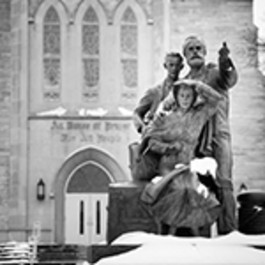In front of this church where graduation exercises transpire stands a bronze statue of the university namesake, John Nevins Andrews. The skilled work of sculptor Allan Collins, this replica of the Seventh-day Adventist church’s first scholar and missionary is shaped with extended arm and hand pointing outward to a world beyond the church. For years now pinned to the wall of my study is this quotation from J. N. Andrews: “I know of but one way: find a field of labor, ask God to help, take off your coat, and pitch into the work.” What is compelling about his personal mission statement is its tacit recognition that most of life (if not all of it) is simply a series of personal choices that reflect opinions and aspirations that are uniquely yours. What someone else considers a fantastic opportunity for career fulfillment or professional advancement might to you seem pedestrian and unappealing. Conversely, an opportunity others might declare unimaginative or so-dead-end might in fact be the high voltage that ignites your imagination and compels you to go. But where does God want me to go? Note carefully the sequence in Andrews’ lifework mantra: first, you find a place on earth where a great need matches your life quest; then ask the God who has already gifted you to help you serve Him there (in that village, that city, that wherever). But is that modus operandi the way God really operates? It’s precisely what He promised a new leader on graduation day long ago: “‘Have I not commanded you? Be strong and of good courage; do not be afraid, nor be dismayed, for the LORD your God is with you wherever you go’” (Joshua 1:9 emphasis supplied). When God promises “wherever you go,” He means—“you choose, I bless . . . you go, I accompany.” Stunning, isn’t it? Andrews was right. I.e., you pick the opportunity, you choose the field—and then asking God to help you, you pitch in to alleviate the human need in front of you. The graduate who spends her days calculating her move and choreographing her future will be of little help in a world so desperately in need right now. So as you march out of this church for the last time, do yourself and God a favor. Glance one more time at the statue. It still speaks. And its hand is still pointing you to the way.
Pastors' Blog
By Pioneer Pastors

The still unfolding heartache of the capsized Korean ferry Sewol with its entombed teenage passengers has gripped the world. Reports of text messages and phone calls from some of the high school students trapped inside the overturned and slowly sinking vessel (though many of the messages are now considered hoaxes) were fresh wounds in a nation mourning the numbing deaths of so many of its promising young. The anguished wail of one of the parents should haunt us all. CNN reported: “Boat after boat, body after body from a capsized South Korean ferry came ashore Sunday morning, a solemn process interrupted by piercing cries and screams from passengers’ kin. . . . After an inspection, [the bodies] were carried along a path guarded by police—who themselves shed tears—and past even more outwardly emotional family members. These relatives cried and, in some cases, yelled loudly, clearly overtaken by the moment. Some of those shouts came from inside the identification tent. One man yelled out, ‘Wake up! Wake up, please!’” (http://www.cnn.com/2014/04/19/world/asia/south-korea-ship-sinking/index.html?iref=allsearch) The image of that father weeping over the recovered body of his child, “Wake up! Wake up, please!”—how could we ever forget it? And yet it is—perhaps not for us, but for the Father of this world—an even more stunning and urgent reality that an entire civilization today is entombed in a morally, spiritually capsized planet that will eventually slip beneath the cold waters of death. Unless they are rescued, tens of thousands of millions, even billions, will perish. Are you among the already rescued, among those men, women and children who have the blessed fortune of having been snatched from impending spiritual death? Shall we sit on the shoreline of this sinking planet, thanking our Savior for our own salvation, bemoaning those still entrapped, but doing nothing for their rescue? How could we sleep at night were we to actually hear the anguished cries from a planet that loses two of its inhabitants to death every single second? “Wake up! Wake up, please!” The bloody tree atop Calvary is a measure of the Love that loudly rejoices over every rescued soul, but mournfully weeps over every life unresponsive, reached too late. “Wake up! Wake up, please!” While this school year now ends, the unfolding tragedy of this sinking, perishing planet does not. “Rescue the perishing; don’t hesitate to step in and help. If you say, ‘Hey, that’s none of my business,’ will that get you off the hook? Someone is watching you closely, you know—Someone not impressed with weak excuses” (Proverbs 24:11, 12 The Message). Wherever this summer journey takes us, I pray it will somehow immerse you and me in Christ’s rescue mission. Because the good news is that “Wake up! Wake up, please!” can come true, and the entrapped can wake up and be rescued while there still is time. (If you would like to be part of our “rescue mission” to south Mexico July 17—August 4, call the church office [269.471.3134] for details on how to join the team.)

On April 1 an 8.2 magnitude earthquake erupted in the shallow ocean floor off the coast of northern Chile. It’s was no April Fools prank. The energy force the quake released was the equivalent of over 30 megatons—thirty million tons—of TNT. For comparison, a 1 megaton bomb is capable of destroying 80 square miles. Imagine thirty times that destructive force and reach! The story of Easter, as told by Matthew in the original Greek, describes a massive temblor that predawn morning: “There was a violent earthquake, for an angel of the Lord came down from heaven and, going to the tomb, rolled back the stone and sat on it” (Matthew 28:2). The words Matthew chose are megas seismos—from whence comes our English transliteration to describe a “mega seismic” event. Interestingly, those same two Greek words describe the “mega seismic” event that marks the end of earth’s history as we know it, immediately preceding the fiery, glorious return of Christ (see Revelation 16:18). An earthquake when He died, an earthquake when He arose, and an earthquake when He returns—you get the impression that Christ is the Lord of unbridled power, do you not? Power not measured in megatons of weaponry, but given the cosmic war He leads to rescue this rebel planet from its dark and fallen warlord, power measured in the liberated and set-free lives of human beings who cry to Him for rescue. This Wednesday evening the sanctuary of our campus church was occupied by men, women, young adults and teenagers who gathered together for a special prayer and anointing service. For the past three Sabbaths we have confronted the enemy’s diabolical challenge to the lordship of Christ through demonic addictions. Nobody ever plans to become addicted. The devil’s strategy behind every addiction is to lure us through the tempting bait of pleasure, gratification, appetite, social conformity—we all know (all too well) the can of bait the enemy turns to in order to hook us. But the profoundly good news that pervaded this sanctuary last Wednesday is the glad tidings that permeate this Easter: “If the Son sets you free, you are free indeed!” (John 8:36). Couple that promise with this one: “Christ’s death and resurrection have opened before every soul an unlimited source of power from which to draw” (RH 11-5-1901). Unbridled, undiluted, unlimited megas seimos power from the risen Christ straight to you. Ask for it, ask for Him. And the earth will quake over your deliverance!

It has been a month since the ill-fated Malaysia Airlines Flight 370 disappeared off the radar screens of air traffic control. With its 239 passengers and crew missing and presumed dead, its disappearance has become the greatest unsolved mystery in the history of flight. For the last two weeks air and naval vessels from a cadre of nations have been combing the south Indian Ocean off the western coast of Australia for any sign, any clue at all regarding the missing airliner. Satellite images of out of focus flotsam on the sea have sent search teams scrambling to confirm potential evidence. But thus far no confirmation. No physical evidence that could bring a modicum of comfort or even closure to the families of the missing. Nothing except an erratic and occasional “ping,” which, authorities say, could possibly be the underwater pulse emitted by an airliner’s black box communication recording devise. But like the satellite images, the recent spate of pings has yet to prove conclusive. And so the world waits and the families pray. As I have brooded over this unfolding story and—as is characteristic of this blog site—looked for a “connect” between the headlines and life as we live it today, it has occurred to me that in some mysterious sense the underwater pings are a metaphor of the resurrection. And by that I don’t mean that this airliner full of men, women and children, buried in the depths of the ocean, is a symbol of all the dead who await the resurrection the Bible promises at the end of time. With Easter only a few days away, that promise of hope would certainly be worthy of our reflection. But rather, could it be those intermittent pings can represent an even more stunning truth? The quiet truth that the Father of the universe, the Creator of this errant planet, itself wildly and erratically far far off its intended divine flight plan—could it be that God Himself hears what no other ear can hear—the faint, intermittent pings emitting from a billion fresh and ancient graves the world over—silent pings that mark the patches of earth and sea under which lie the remains of earth children who sought His salvation? To our broken hearts what seems so cruelly stolen from us in death is not lost to Him. Because what “eye hath not seen, nor ear heard” is seen and heard by the Christ who yet cries out, “I am the Resurrection and the Life” (John 11:25). In vain we search for the one who no longer is in our arms, whose breath we feel upon our cheeks no more—lost and gone, our sobs confess. But on this week before Easter, let every heart remember that what the ear cannot hear He can. Wild and stunning truth more glorious than before, God can hear the “ping of hope.” And our dead are not lost to Him. “Even so, come, Lord Jesus. Amen.”

Poor Mary Barra, the new CEO of General Motors. On Capitol Hill for a grilling by a House subcommittee this week, what could she say? Since February GM has recalled 2.6 million cars because of a faulty ignition switch. As it turns out thirteen deaths are now attributed to the defective switch, “which can cause the engine to cut off in traffic, disabling the power steering, power brakes and air bags and making it difficult to control the vehicle” (South Bend Tribune 4-2-14). Thirteen deaths, 2.6 million automobiles recalled—all because of a small switch. Engineers, according to company records, knew about the defective switch back in 2005 but management concluded that the costs for replacing the switch were not “an acceptable business case” (i.e., it cost too much money). The cost of a replacement switch? 57 cents (plus labor). Thirteen deaths and a 2.6 million vehicle recall later is there anybody that still thinks 57 cents was too much? I’m amazed at the notion that in the battle over addiction (the theme of our pulpit series this month), the strategy of prayer is so easily dismissed as a two-bit panacea that really can’t handle the big guns of addiction. And yet leave that 57-cent piece out of the equation, and look at the personal mayhem and heartache that have accumulated as a result. Nobody is suggesting that the simple (but profoundly powerful) act of prayer is all anybody needs to break the back of a life-enslaving addiction (be it drugs, alcohol, sex, nicotine, food, gaming, et al). Mental health professionals recommend an arsenal of strategies and therapies for those who seek to break their addictions—from Twelve Step group therapy to counseling to volunteer community service to medical treatment and more. But it is no coincidence that in the battle against addiction there is amazing unanimity regarding the power of personal prayer or, as the Wall Street Journal put it a few days ago, the power of “frequent involvement in spiritual activities” (3-28-14 A11). So simple, so inexpensive, yet so often dismissed. “Submit yourselves, then, to God. Resist the devil, and he will flee from you. Come near to God and He will come near to you” (James 4:7-8). So simple, so inexpensive, but so potentially life-altering, life-saving. So in your own private battle with addiction, go ahead, take advantage of the large arsenal available today for healing. But whatever you do, do not omit prayer. To make prayer possible it cost God the most expensive enterprise in the universe. And yet for less than 57 cents, you can turn the key in prayer’s ignition every single day, and put your faith in touch with the only One with power enough to set you free. Forever.

Look—I know how uncomfortable it can be, talking about our own weaknesses. But sometimes, in the life of a family or in this case an institutional family, we need to have that collective conversation. And so when the university contacted us about joining with them in a springtime focus on substance abuse, it made sense for the campus church to do just that. After all the Student Movement, our campus newspaper, has just run three major articles dealing with substance abuse. And speaking of being uncomfortable talking about our own weaknesses, I applaud Kimberly Schwirzer for being vulnerable and sharing with editor Melodie Roschman the testimony of her own battle with addiction. “‘Just because it’s an Adventist school, doesn’t mean we can pretend that people don’t drink, don’t experiment with drugs, don’t get into trouble,’” Kimberly told the Student Movement. “‘I went to Andrews to get away from party culture,’ she explains, but what she got was ‘loss of control, and addiction’” (Student Movement 2-26-14 p 3). And she isn’t alone. Not at Andrews University. Not at Andrews Academy. Not at any high school or university in this nation, Seventh-day Adventist or otherwise. There are some who wish we could simply pretend that the grab-bag of addictions prolific in our secular culture (alcohol, drugs, sex, food, et al) doesn’t exist in our faith community—but whom are we fooling, except ourselves? To deny we have a problem only exacerbates the problem and delays any solution. Which isn’t to suggest that a springtime series of sermons—“The Bondage Breaker: How to Win (and Help Your Friends Win) the Battle of Addiction”—is the elixir to heal our addictions. The truth is, only Jesus can free the captive: “‘The Spirit of the Lord is upon me, because He has anointed me . . . to let the oppressed go free’” (Luke 4:18 NRSV). Which means: “‘If the Son sets you free, you will be free indeed’” (John 8:36 NIV). But is Jesus too simplistic a solution to our addictions? I don’t think so. Not if the dark world of addictive behavior is the manifestation of an even darker and more desperate war, fought not only within us, but raging invisibly around us. “For our struggle is not against flesh and blood, but against the rulers, against the authorities, against the powers of this dark world and against the spiritual forces of evil in the heavenly realms” (Ephesians 6:12 NIV). Plain and simple, we need the Bondage Breaker. And in tandem with Him some practical, repeatable actions we can take to personally experience His promised deliverance from our addiction. So take the journey with me—do it for your friends, do it for yourself. And be assured that Pioneer will be a safe, welcoming place for you, no matter your addiction or struggle. Because we’re all in this together. With the One who has already won.

After all the grey and cold and dreary weariness of this interminable winter, how about something to lift your spirits? Thanks to Susan Reimer, a columnist for the Baltimore Sun, I found out about some new research that has identified just what it is that makes us happy. We’ve all known that experiences produce a more lasting happiness than possessions. But which experiences make us the happiest? Reimer reports on the research of two marketing professors, Amit Bhattacharjee of the Tuck School of Business at Dartmouth and Cassie Mogilner of The Wharton School at the University of Pennsylvania. Their study titled, “Happiness from Ordinary and Extraordinary Experiences,” endeavored “to separate experiences into those two broad categories: extraordinary (uncommon and infrequent), such as the birth of a child or a trip to Hawaii; and ordinary (common and frequent), such as feeling the sun on your face on a summer morning [anybody remember what that was like?] or sharing pizza and a movie with the kids” (SBTribune 3-2-14). Can you guess what they discovered? I was surprised. “They found that younger people, who view the future as infinite and who are collecting experiences to help define who they are, gain more happiness from extraordinary experiences.” But as we age, these researchers discovered, we “begin to view [our] remaining time as limited” and thus we “get as much happiness from the ordinary experiences that are part of [our] daily lives.” Susan Reimer quotes them: “‘While younger people tend to define happiness in terms of excitement, enthusiasm and high stakes arousal, older people define happiness in terms of calm peacefulness and low states of arousal’” (ibid.). Reimer summarizes their findings: “We still love thrills as we age. . . . Extraordinary experiences give young and old almost the same amount of happiness. But happiness from ordinary experiences increased as people got older.” And then she quotes from an essay by 93-year-old Roger Angell in a recent New Yorker magazine. And I like the way he puts it: “We’ve outgrown our ambitions. If our wives and husbands are still with us, we sense a trickle of contentment flowing from the reliable springs of routine, affection in long silences, calm within the light boredom of well-worn friends, retold stories and mossy opinions” (ibid.). Oh, I like that—and I’m not even 93! The aging Wiseman once put it: “He has made everything beautiful in its time. Also He has put eternity in their hearts” (Ecclesiastes 3:11). At every stage of the human journey, at every age of our lives, God offers to us an experience that is “beautiful in its time.” What makes you happy at your age may not be what makes me happy at mine. Nonetheless, whatever the age, there is happiness and beauty tucked away in our hearts by the God who turns even the ordinary into “beautiful in its time.” And the grayer we turn, the quieter we become, the more and still more of eternity God keeps pouring into our hearts. Until one day at 33 or 73 or 93, we walk off the stage of time, hand in hand with the Eternal, who through all the ordinary and extraordinary moments of life brought to us the very gift in that very moment we were needing most. What a Friend is this God who ages with us all the way into Eternity!
Have you seen the recent video clips making the rounds? I have. And since this blog is called “The Fourth Watch” (the last watch—3 a.m. to 6 a.m.—in the Roman reckoning of night time) and since this blog’s purpose is to track indicators in the world portending the end of this civilization’s long night and the nearness of Christ’s return—I would like to comment on these forwarded web messages that are circulating. The forwarded link is to a YouTube recording of Bishop Tony Palmer. (His Anglican affiliation is not clear according to online sources—and he is described at this site as a “personal friend” of Pope Francis.) In the clip Palmer is addressing a recent convocation of evangelical Pentecostal ministers in Texas and makes a passionate appeal for unity between Rome and the Pentecostal movement: “We are living in an incredibly important generation. I believe that God has brought me here to this year’s ministers conference in the spirit of Elijah.” Palmer then describes this Elijah spirit as the spirit of reconciliation that brings back the fathers to the sons and the sons to the fathers (http://www.youtube.com/watch?feature=player_embedded&v=b5TwrG8B3ME). And then seven minutes into this clip this Protestant bishop brings a personal message from Pope Francis. But in a rather unusual manner, this message is more than a read statement relayed through an emissary. After quoting Jesus’ prayer in John 17, “That they may be one as We are One, Father,” Palmer directs the convention’s attention to the big screen for a seven minute video recording of Pope Francis personally greeting the gathered ministers. I must say it is an amazing piece of personable, warm, collegial greeting from the Pope, given in Italian with English subtitles, apparently filmed (it feels like a home movie) by Bishop Palmer himself, whom the Pope describes, “we’ve been friends for years.” And the message is unmistakably clear. We are separated now because “it is a long road of sins that we all shared in. Who is to blame? We all share the blame. . . . I am nostalgic [yearning], that this separation comes to an end and gives us communion.” At one point appealing to the story of the reunion of Joseph with his brothers in Egypt, Francis declares: “But we have to encounter one another as brothers. We must cry together like Joseph did. These tears will unite us. The tears of love. . . . I thank you profoundly for allowing me to speak the language of the heart. . . . And this is a miracle. The miracle of unity has begun. . . . [God] will complete this miracle of unity. I ask you to bless me, and I bless you.” (If you want to watch the Pope’s message by itself, go to http://www.youtube.com/watch?v=dHXKTKYunYo). Is there something sinister in Christian brothers seeking unity in Christ? Hardly. But on the basis of the Apocalypse and the Great Controversy I remember that there is predicted before the return of Jesus a global unification that will transcend religious and theological lines. A global, ecumenical, political unification championed by Rome and the United States. “The opinion is gaining ground that, after all, we do not differ so widely upon vital points as has been supposed, and that a little concession on our part will bring us into a better understanding with Rome” (Great Controversy 563). But there is a line Bishop Palmer did not read from Jesus’ prayer for unity: “Sanctify them by Your truth; Your word is truth” (John 17:17). Lasting, meaningful unity in Christ can only be built upon the solid Rock of the Word of God. Which means you and I, whatever our persuasion, must only be persuaded by a “Thus says the Lord.” Unity pursued on any other ground will never be unity. No matter how many home movies are played.

With the winter Olympic games in Sochi, Russia, nearing their grand finale, you have to admit—the herculean efforts and protracted training endured by these young athletes of the world is astounding. And it’s not like they were suddenly impressed or inspired a year ago to take a shot at the Olympics. These athletes have been locked onto this Olympic dream for years. And even longer than that as fellow Michiganders Meryl Davis and Charlie White have shown us. They were just kids (eight and nine years old) 17 years ago when they began skating together. Their mothers thought it was cute. But nobody fathomed that it was the beginning of 17 years of ceaseless practicing, competing, practicing, competing—all for the sake of their pubescent dream to win an Olympic gold—a long seventeen-year dream that came true this week with their celebrated gold medal for pair figure skating (the first in U.S. Olympic history). Wow! I’m not suggesting we all drop our what-feels-so-mundane-in-comparison living and embrace the Olympic dream (do they have an Olympics for “old” people?). But if these young athletes are willing to endure the relentless rigors of prolonged and protracted training and pain and practice and retraining and more pain and falling and failing, over and over again for years, what are you and I willing to endure for the sake of Christ’s calling? One of the Olympian greats of sacred history actually referenced the Olympic games to make a point I hope we don’t soon forget: “Everyone who competes in the games goes into strict training. They do it to get a crown [gold medal] that will not last; but we do it to get a crown that will last forever. Therefore I do not run like a someone running aimlessly; I do not fight like a boxer beating the air. No, I strike a blow to my body and make it my slave so that after I have preached to others, I myself will not be disqualified for the prize” (1 Corinthians 9:24-27 NIV). Like an Olympic athlete, Paul envisioned himself under intense unrelenting spiritual training, with one unshakeable dream—to win the gold. “Run [run, run] in such a way as to get the prize” (v 24). A rather testosteroned call for our generation, wouldn’t you say? But why not? If the Sochi athletes have poured their lives out for the sake of standing on the Olympic podium, shouldn’t we who are known followers of Jesus be willing to sacrifice what we have—our time, our energy, our resources, our reputation, our careers even—for the sake of standing tall on the podium for Christ? What is it Jesus is calling you to do for Him with your life or what is left of it? Of course being a disciple of His is costly. But wanting it cheap is like a couch potato dreaming of gold. The gold will cost you everything. It did for Jesus on the cross. And it will for you and me if our sights are higher than Sochi.
5,700 feet underground is enough to stir up anybody’s latent claustrophobia. Although I suppose that if you’re used to being that far down and are doing it for a living (as miners do), it’s pretty much old hat to you. Unless, of course, your way back up to the surface has been blocked, as was the case this week with South African miners in the Harmony Gold mine west of Johannesburg. They were digging over a mile underground when apparently a magnitude-2.4 tremor shook a large rock loose, tumbling it into a metal cable, causing a spark that ignited combustible material into an underground fire, trapping eight men in that subterranean dark. Several years ago in almost the same place in South Africa I descended 742 feet into a gold mine in a small elevator with other tourists (the certificate of proof is still on my study wall)—and trust me, I was more concerned about getting back up to the surface than enjoying the chilled-air sights of that abandoned mine! I can’t imagine the concerns of these miners this week trapped so much farther down. Although on this Black History Sabbath, it may not be so difficult to imagine a vast swath of this nation and this world’s populace trapped in the deep shaft of poverty. It is pointless to remonstrate that some of those trapped are bound by circumstances that they themselves have created. Shall we therefore consider them unworthy of our concern, unfit for compassionate intervention or at least acts of unselfish charity? Nonsense. The fact is that more and more Americans are being trapped by the economic vice that is squeezing more and more of us from the middle class into the lower class, the poorer class. The college educated represent the fasting growing demographic of those now applying for food stamps in this nation. A record one out of 6 Americans is now on food stamps (http://www.csmonitor.com/USA/DC-Decoder/2014/0204/Does-slicing-8-billion-from-food-stamps-cut-to-bone-or-just-trim-some-flab-video). Shall we conclude that it really is none of our concern here in the rural St Joseph River valley? Let the inner cities find their own escape from entrapment. Let Congress cut $8 billion from the food stamp program or argue over the entitlement programs (as they did this week). What’s it to such fervent “We have this hope” Adventists like you and me? Maybe everything. Commenting on Jesus’ familiar words in His final parable about the sheep and the goats and “the least of these brothers and sisters of Mine” (Matthew 25:40 NIV), Desire of Ages makes this startling observation: “[Jesus] represented [the judgment’s] decision as turning upon one point. When the nations are gathered before Him, there will be but two classes, and their eternal destiny will be determined by what they have done or have neglected to do for Him in the person of the poor and the suffering” (637). Black and white, red or yellow, it doesn’t matter—the unfailing standard in the final judgment will be what we have don e or neglected to do for Jesus “in the person of the poor and the suffering.” Period. Which means that all of us gathered today in worship are under the obligation of Christ’s compassion toward us to in turn live out that compassion toward those we clearly know are trapped beneath the surface of this life and can only be set free if we will volunteer, if we will give, if we will reject racial stereotypes for the sake of living out Jesus’ radical love. Right now. Right here. Amen.
- ‹ previous
- 35 of 64
- next ›
